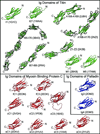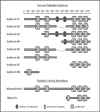Cytoplasmic Ig-domain proteins: cytoskeletal regulators with a role in human disease
- PMID: 19466753
- PMCID: PMC2735333
- DOI: 10.1002/cm.20385
Cytoplasmic Ig-domain proteins: cytoskeletal regulators with a role in human disease
Abstract
Immunoglobulin domains are found in a wide variety of functionally diverse transmembrane proteins, and also in a smaller number of cytoplasmic proteins. Members of this latter group are usually associated with the actin cytoskeleton, and most of them bind directly to either actin or myosin, or both. Recently, studies of inherited human disorders have identified disease-causing mutations in five cytoplasmic Ig-domain proteins: myosin-binding protein C, titin, myotilin, palladin, and myopalladin. Together with results obtained from cultured cells and mouse models, these clinical studies have yielded novel insights into the unexpected roles of Ig domain proteins in mechanotransduction and signaling to the nucleus. An emerging theme in this field is that cytoskeleton-associated Ig domain proteins are more than structural elements of the cell, and may have evolved to fill different needs in different cellular compartments. Cell Motil. Cytoskeleton 2009. (c) 2009 Wiley-Liss, Inc.
Figures




References
-
- Agarkova I, Ehler E, Lange S, Schoenauer R, Perriard JC. M-band: a safeguard for sarcomere stability? J Muscle Res Cell Motil. 2003;24:191–203. - PubMed
-
- Agarkova I, Perriard JC. The M-band: an elastic web that crosslinks thick filaments in the center of the sarcomere. Trends Cell Biol. 2005;15:477–485. - PubMed
-
- Aihara Y, Kurabayashi M, Saito Y, Ohyama Y, Tanaka T, Takeda S, Tomaru K, Sekiguchi K, Arai M, Nakamura T, Nagai R. Cardiac ankyrin repeat protein is a novel marker of cardiac hypertrophy: role of M-CAT element within the promoter. Hypertension. 2000;36:48–53. - PubMed
-
- Alyonycheva TN, Mikawa T, Reinach FC, Fischman DA. Isoform-specific interaction of the myosin-binding proteins (MyBPs) with skeletal and cardiac myosin is a property of the C-terminal immunoglobulin domain. J Biol Chem. 1997;272:20866–20872. - PubMed
Publication types
MeSH terms
Substances
Grants and funding
LinkOut - more resources
Full Text Sources
Miscellaneous

